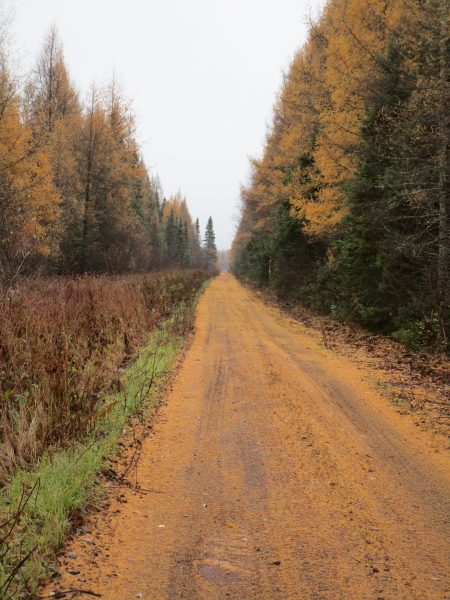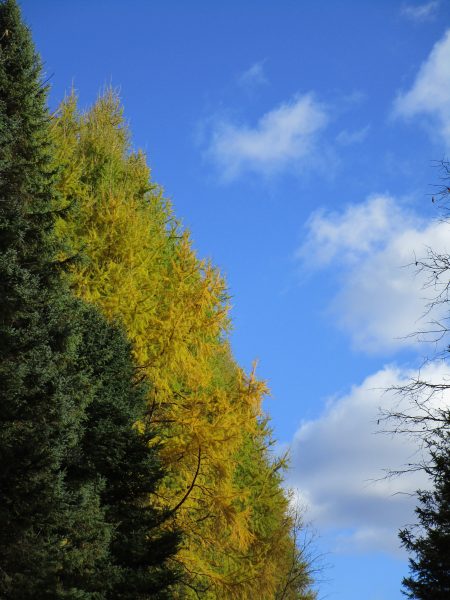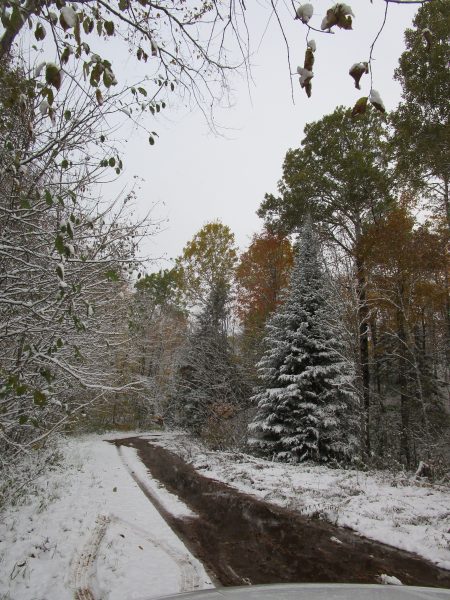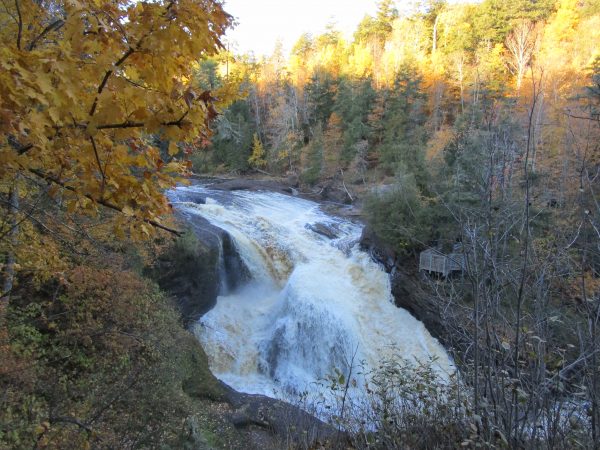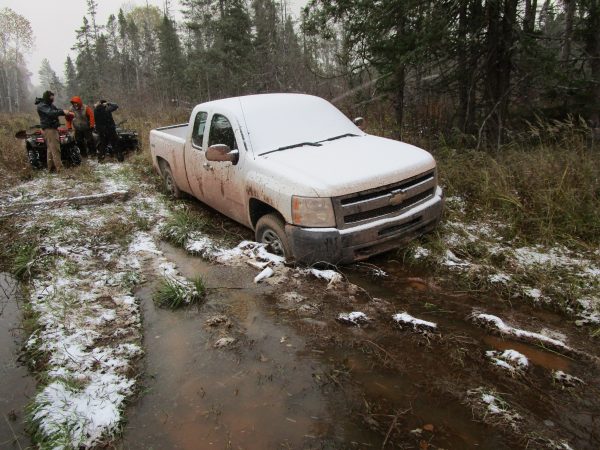In August, I participated in endangered black-footed ferrets surveys! They were amazing, to put it shortly. Not only did we look for them, but we trapped them too!
Each of the interns were given a partner and truck. The night consisted of surveying in the truck and surveying on foot. It was overnight because BFFs are nocturnal, so we used their unique blue-green eye-shine to spot them. From the inside of the truck, my partner (a writer for Defenders of Wildlife) drove while I scanned the horizon with a truck spotlight, both of us going very slowly. On foot, it was basically the same idea. So when we saw eye-shine, we had to be sure it was a ferret and not a fox, cow, pronghorn, or something else. Figuring it out was actually really fun! If the eye shine looked more like one eye than two eyes, that meant the eyes were close together and small, perhaps belonging to a ferret. If the eyes bob up and down, moving fast along the ground, that’s probably also a ferret! We knew eye shine didn’t belong to a ferret when they were yellow and motionless because that always belonged to the cows. However, sometimes we were surprised at what we saw. For example, a couple times we thought we were looking at a fox or a pronghorn, but we were actually looking at a ferret!. It goes to show, always be sure and don’t trust your first perceptions!
After determining it was a ferret, there were several steps we had to take to complete the whole process.
- Spot the ferret eye-shine.
- Keep handheld spotlight on ferret while walking towards it, bringing a pack with a couple traps, transfer tubes, markers, and plugs (containers used to plug burrows).
- See the ferret in the hole! Rejoice! Set the traps, place the traps, find other holes to plug.
- Leave the site, continue in truck or on foot surveying for ferrets.
- Every hour, check the traps for ferrets.
- When you see a ferret in the trap, try not to squeal with excitement like I did! Carefully transfer them into a transfer tube!
- Carry the tube of ferret gently but briskly back to the truck and drive to the processing trailer.
- Once at the trailer, the specialist anesthetizes the critter. Then, she’s able to PIT tag the ferret (if not a recapture), get a hair sample, take measurements, sex it, age it, check for ticks and fleas, and the most important part: vaccinate it for canine distemper and sylvatic plague!
- Tattoo the fur of the ferret so that we can recognize it as a recapture.
- Finally, we take the ferret in a kennel back to its home and release it! This is one of the most rewarding steps of the night!
While experiencing all this, I did a lot of reflecting. I could definitely see myself doing ferret surveys, or other small mammal surveys, as a career. I fell in love with these animals, and now I’m going to share why!
SO, everyone knows the black footed ferret story and how they’ve given hope to conservationists. Previously thought to be nearly extinct, a small population was found thanks to a rancher’s dog bringing home a dead ferret. Years later, a program of captive breeding and reintroduction proved to be successful, and now similar programs across North America are helping to continue the recovery of black-footed ferrets! The BFF’s story lets us know that captive breeding and reintroduction can work. Humans can fix at least some of the problems we have caused! Conservation is not a hopeless line of work!
Having to be awake, alert and working from 7:30pm – 8am for three nights was 100% worth the experience. In those nights, my partner and I identified at least 9 ferrets one day (I didn’t get a chance to tally up how many total for three days, but the number for the other two days shouldn’t be too far off) and successfully trapped 5 total! This is really exciting for me, considering how rare they are to find. We must have hit the jackpot location! Our first ferret was a sweetie, the second was a demon, third was possibly the first ferret’s offspring, and we think our fourth and fifth were brothers. Even though the surveys gathered general data on the ferret populations, it was also a teaching moment on animal personalities. One of my favorite experiences of the night was getting to witness all the different personalities!
Our first ferret was a young mother who was very sweet and docile. If I had to pick favorites, it would be her! Seeing her face in the trap was one of the most precious moments ever because I was prepared for an aggressive animal (I would be if I were her!) but instead, she just stared at us with innocence and curiosity. She never hissed, barked, pounced, clawed at us, or bared her teeth–its like she trusted us. Of course, I have no idea what she was feeling or thinking. She might have actually been frozen with fear. Still, she wasn’t shaking like some of the other ferrets so I hope I’m right!
My partner and I had a lot of adventures in only three nights, but I’ll only share a couple that really stood out to me.
Our second ferret was somewhat of a disaster, unfortunately. He was a kit, or juvenile, and won the title for Most Aggressive Ferret of the Year in my book. Most of the ferrets we found in burrows were playful. They would hop in and out of burrows, sometimes giving us a chase, all the while watching us! He was one of those, but changed completely when we found him in the trap. Even just as we were approaching the trap we could hear him making a fuss. Transferring him from the trap to the transfer tube proved to be difficult because he kept pouncing and snapping at the trap door. He even bit my fingers when I tried opening the door! Luckily, I was wearing winter gloves and it didn’t leave a scratch. So, after we finally got him in the transfer tube, we could feel him shaking and hissing the whole way to the trailer. The trailer is where the real horror began. Everything seemed fine, the specialist was going through her usual routine of placing him in another tube for anesthetization. Except, it was taking a bit longer than usual for him to be knocked out. Finally, he was knocked out and the specialist slumped him out on the table. All of a sudden, I hear “Oh no” from the specialist. I look over and see that he is standing and looking back at all of us, seeming to be digesting his surroundings, and his neck is pink with blood. There was a moment of pause that seemed like a minute but was probably less than three seconds. In that time, what struck me was the blood, but what should have struck me was that he was awake. Then, chaos ensued. The specialist quickly made an attempt to grab him, but he was quicker and started trying to climb the walls. She turned around to look for thick gloves, found them, and then told us to keep the door shut. There were four of us all together packed into a trailer that’s really only big enough for one or two people. So the rest of us don’t make a peep, trying to be as small and out of the way as possible because now the kit is literally running around the trailer. Behind the desk, through the clutter of equipment, under the table, around our feet. A sharp, acrid smell starts to creep into my nostrils and invade my throat. The kit was so frightened it had urinated somewhere. After enough of this had passed, the specialist finally catches the poor thing and puts him in one of the cages we use to release the ferrets. After a breather, she explains to us that this boy has had enough trauma for one day and will be pardoned from the vaccines, anesthetic, and the rest of processing. She also explains the wound on his neck. I had feared that it was self-inflicted from being in the anesthetic tube, but she mentioned it was there when she saw him initially. So, it could have been from rough play with his siblings. Still, I couldn’t help feeling responsible for his trauma. I get tasked with carrying the cage of stinky ferret and we go back to his burrow. Whats interesting is that on the way back, we noticed he wasn’t shaking anymore. Either he had calmed down or had exhausted himself. Maybe, he was hoping he’d be on his way back home. Either way, he was less anxious and we were glad for it. When we set his cage down next to his burrow and I opened the door, he slowly walked out, paused to look at us, then walked down into the burrow. We were both happy he was back.
We caught our fourth and fifth ferrets in the same area as our second ferret and within an hour of each other. This was the craziest spot because we saw SO many ferret eye shines. We ran into a few problems: our flashlights died (common occurrence) so we had to use our head lamps and our phones to search for the burrows, which is actually REALLY difficult at 3:00am in pitch black darkness. We even ran out of plugs and had to use random objects to fill holes, like rocks and our dead flashlights, and we kept finding ferrets when we were busy with another ferret! When we checked the four traps an hour later, none of them had a ferret. Luckily, we found ferret eye shine not too far away from one of the traps. So, when we got back to check our traps, we checked them in the order we set them. None of them ended up having a ferret, BUT, one of our traps seemed to be broken and it was laying on the floor, like a ferret had escaped! When we saw that, we also saw another ferret not too far away! So we grabbed that trap and found the other (or same?) ferret and trapped this guy! We left and preceded to the rest of our traps, actually, it was time to take them down so that’s what we did with the other traps. When we came back, we found a ferret in our trap! Guess what, we found ANOTHER ferret not too far from that one! BUT we didn’t have any other traps. So guess what we did. My partner went to look for the ferret while I hurriedly tried to unlock the trap door with my frozen hands and transfer the patient ferret to a transfer tube. It seemed like it took me forever, because this was an old trap and the door was stuck and I had trouble with not getting my fingers bitten by the pouncing (and not so patient) ferret inside the trap. Finally, I transferred the critter and let him rest in the tube while I brought the trap to my partner and her new ferret! So, we put the traps down and brought our ferret to the trailer. By the end of it, the specialist didn’t think there was enough oxygen for another ferret, so when we brought our ferret back to its burrow and checked the trap we just put out, we couldn’t bring the ferret to be processed. The specialist had us bring the pit tag reader so that we could at least check the ferret to see if it was a recapture from precious years. The crazy thing is, out of all the five ferrets, our last one was the only recapture! Which worked out perfectly for us because we wouldn’t have been able to bring the ferret to processing anyways!
When it comes to animals, I like to give the benefit of the doubt that they have feelings and emotions that might be similar to humans because we simply cannot rule that out. Sometimes I feel like I have a double identity of polar opposites. One half of me is made of science and logic and the other half of me is controlled by emotions and intuition. Even though I feel out of place in both scientific communities and artistic communities, I appreciate both sides because it gives me a mashup outlook on everything. In the case of the ferrets, my capability to empathize gave me the attention to detail to notice differences in personality between the ferrets we caught.

















